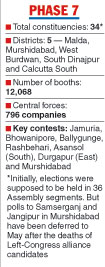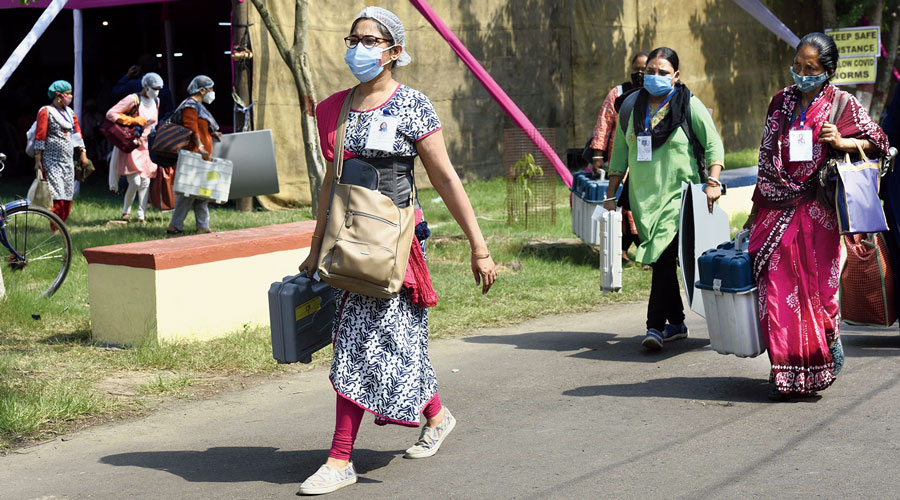Four of 11 Assembly segments in Calcutta — Calcutta Port, Bhowanipore, Rashbehari and Ballygunge — go to the polls on Monday.
Voters in the remaining seven — Chowringhee, Entally, Beliaghata, Jorasanko, Shyampukur, Maniktala and Kashipur-Belgachia — will exercise their franchise on Thursday, the last day of the eight-phase polls in Bengal.
Of the 294 seats in Bengal, Calcutta has barely 4 per cent, but being the state capital, winning city seats is a matter of prestige for political parties.
In the 2016 Assembly polls, Trinamul had won all 11 seats comfortably. The 2019 Lok Sabha polls, however, sent a warning signal to the ruling party as the BJP secured leads in Rashbehari, Jorasanko and Shyampukur Assembly segments. The BJP breathed down Trinamul’s neck in two more — Maniktala where Trinamul had a slender lead of less than 1,000 votes, and Bhowanipore, a constituency represented by chief minister Mamata Banerjee, where the ruling party had a 3,500-vote lead.
Ahead of the two-phase polls in Calcutta — where over 30 lakh people will cast their votes — The Telegraph takes a look at the factors that make the battle for the state capital so intense.

Covid fear
Calcutta recorded 3,779 new Covid cases and 18 deaths on Sunday and the steady northward climb in infections has created panic in the city.
The casualty of this Covid-19 fear could be poor voter turnout.
Calcutta records around 64 per cent voter turnout, but poll panel officials think the figure would be lower this time.
“The effect of the pandemic has been seen in urban North 24-Parganas, where polling percentage declined significantly,” said a poll official.
Against this backdrop, the poll panel has taken up several measures to build confidence among voters by splitting booths to bring down number of voters per booth, making wearing of masks mandatory and distributing gloves and sanitisers at booths.
The Election Commission banned rallies, road shows and large meetings before the last two phases. The poll panel extended the silence period to 72 hours from 48 hours in view of the surge in Covid-19 cases.
Leaders of Trinamul and the BJP said these last-minute changes threw their last-hour campaign plans awry.
Trinamul insiders, however, said Covid-related curbs could help them. “The BJP’s traditional voters live in highrises and are unlikely to come out to vote. It will be a boon for us,” said a Trinamul source.
Outsider debate
Several political observers this reporter spoke to said that bohiragawto or outsiders — a tag that Trinamul had hurled at the BJP — will be crucial.
With Trinamul repeatedly calling BJP star campaigners — like Prime Minister Narendra Modi, Union home minister Amit Shah and several other leaders visiting the state frequently or camping in Bengal for the election campaign — outsiders, the issue is a talking point.
Trinamul had pitched the election as a battle between Bengal and outsiders trying to invade the state, but this has its pros and cons.
The language used by many BJP leaders in campaigns has led many Calcuttans to believe the BJP has scant respect for Bengal’s culture.
“It started with the demolition of the bust of Ishwarchandra Vidyasagar ahead of the 2019 Lok Sabha polls. Then Amit Shah could not identify the statue of Birsa Munda. They don’t know where Rabindranath Tagore was born. I don’t feel safe when I see the BJP’s all-out efforts to come to power in the state,” said Subhasis Pal, the owner of a sari shop in Bhowanipore.
At the same time, the outsider campaign by Trinamul initially caused some worry among some non-Bengalis in Bengal. Trinamul realised this and Mamata tried to assure non-Bengali communities a couple months ago that the outsider tag was only for BJP leaders who came to the state ahead of polls.
The results of Jorasanko and Shyampukur will depend on whether non-Bengali Calcuttans have accepted Mamata’s take on “outsiders”. Nearly 45 per cent of the residents of these areas are non-Bengalis. This is why the BJP is eyeing these two seats.
Voter mindspace
Trinamul has a strong base among the middle class in the city, who form nearly 40 per cent of Calcutta’s population.
A retired bureaucrat, who served in important positions such as state home secretary, said most middle-class families in Calcutta are informed about what is happening in BJP-ruled states and are apprehensive of the saffron party. “(Urban) Bengalis usually don’t want problems over issues such as food habits or religion. They have seen troubles over these issues in some northern states where BJP has been ruling for years. This is why they are anti-BJP and Trinamul will benefit from this fear of the BJP,” he said.
Also, Calcutta has no bitter experience with Trinamul unlike in some rural areas.
“A section of people in the rural Bengal are angry with local Trinamul leaders as they demand cut money for government benefits. The urban middle class does not have that experience as they hardly depend on government schemes like Banglar Awas Yojana or free bicycles,” said a political observer in the city.
The urban middle class is largely happy with Trinamul’s civic services in Calcutta.
Another issue that has drawn the Trinamul closer to the middle class is its opposition to repeal the urban land ceiling act. “The BJP is in favour of doing away with the Act. If the act is withdrawn, no middle class family will be able to live in the city peacefully as outsiders will try to buy our plots forcibly,” said Adhir Das, a government employee who lives on Sarat Bose Road.
The city has 3,000 registered slums with 18 lakh residents and Trinamul has an edge among this section. Trinamul insiders said slum dwellers got benefits under government schemes such as homes, pension or Swasthya Sathi cards. “This was possible for two reasons. First, the CMC actively monitored the projects. Second, city councillors did not demand money in lieu of these benefits,” said a Trinamul insider.
Another issue that has made Trinamul popular in slums is the urban daily wage scheme on the lines of MGNREGA. Launched during the Left era with the active participation of Asok Bhattacharya, then urban development minister, the Trinamul-led government took it forward in a proper manner. “Every day, some 25,000 people get jobs under it,” said a source in the CMC.
The Trinamul, however, is concerned about young voters. Urban Bengal has 1.25 crore people aged between 16 and 25 years, and a large number of them stay in Calcutta.
“According to a rough estimate, 2 to 3 lakh voters of around 30 lakh voters in Calcutta are aged below 25. They are aspirational, they want corporate jobs. In the last Lok Sabha polls, we feel a large section of these voters went against us. This is why we have stressed in our poll promises things like IT,” said a Trinamul leader.
Overall, Trinamul leaders seem sure of getting nine of 11 seats in Calcutta.
However, Sayantan Basu, a state BJP general secretary, disagreed. “All these predictions regarding Calcutta will go wrong this time. The new government that the BJP would form will have representation from Calcutta as well,” Basu said.











